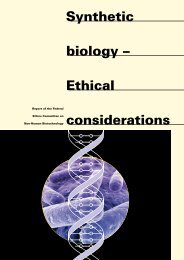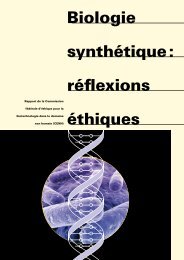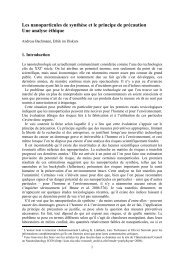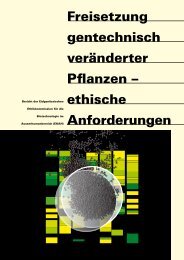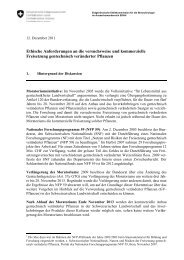Helmut Segner Fish Nociception and pain A biological perspective
Helmut Segner Fish Nociception and pain A ... - EKAH - admin.ch
Helmut Segner Fish Nociception and pain A ... - EKAH - admin.ch
- No tags were found...
Create successful ePaper yourself
Turn your PDF publications into a flip-book with our unique Google optimized e-Paper software.
pathways are ultimately converging on the same subcortical <strong>and</strong><br />
limbic structures that are directly accessed by ascending spinal<br />
pathways (Price 2000). The few examples may illustrate that<br />
the generation of <strong>pain</strong> is anything else than a linear translation<br />
of a nociceptive signal into <strong>pain</strong> sensation, but results from a<br />
complex crosstalk between different regions in cortex, subcortex<br />
<strong>and</strong> brainstem. There is general agreement that the extent to<br />
which a <strong>pain</strong> stimulus is experienced as an affective or emotive<br />
state depends upon parallel <strong>and</strong> serial activities in different<br />
areas of the <strong>pain</strong> matrix (Tracey 2005). Nociceptive input is<br />
rapidly conveyed to multiple brain regions that collectively, as<br />
a circuit, are capable of processing the input. The fact that <strong>pain</strong><br />
perception is an integrated brain activity is undisputed, only the<br />
relative importance of specific regions or pathways is subject of<br />
on going discussions. For instance, while Pessoa <strong>and</strong> Adolphs<br />
(2010, 2011) emphasize the importance of cortical activities, de<br />
Gelder et al. (2011) point to the essential role of subcortical regions.<br />
Both groups, however, do not claim that <strong>pain</strong> perception<br />
takes place either in cortex or subcortex, but they emphasize<br />
the idea of the <strong>pain</strong> matrix.<br />
3. <strong>Nociception</strong> <strong>and</strong> <strong>pain</strong> perception in fish<br />
When studying <strong>pain</strong> in animals, a principal obstacle is that we<br />
have no direct access to their subjective experience <strong>and</strong> feelings.<br />
While we still can record the sensing of environmental stimuli,<br />
the feelings <strong>and</strong> emotions possibly associated with the sensing the<br />
stimuli have to be deduced from the presence <strong>and</strong>/or response<br />
of operational indicators of the emotional states. Typically, parameters<br />
which connect in an identifiable <strong>and</strong> defined way with <strong>pain</strong><br />
perception in man are used as operational indicators, <strong>and</strong> these<br />
indicators are then studied in animals in order to infer from their<br />
presence or absence on the capability of <strong>pain</strong> perception in the<br />
animal under study (Bateson 1991, Rose 2007, Cottee 2012). Rose<br />
(2007) provides an illustrative example of this approach:<br />
“Stress in man is characterized by an elevation of plasma cortisol<br />
levels. Thus, stress may be operationally defined as ‘elevation of<br />
plasma cortisol levels’. If an animal in a stressful situation shows<br />
an increase of plasma cortisol levels, we infer that this animal experiences<br />
stress, in reference to what we know from man. In the<br />
case of cortisol <strong>and</strong> stress, it is easy to accept that ‘cortisol’ is a<br />
valid operational indicator of ‘stress’; however, it is much more<br />
problematic to identify a valid operational indicator for complex<br />
cognitive properties <strong>and</strong> emotive states such as ‘feeling of <strong>pain</strong>’.”<br />
The problem may be exemplified by the controversial discussion<br />
on the role of the neocortex for an animal’s capability to sense<br />
<strong>pain</strong>. In man, the neocortex is of central importance for conscious<br />
<strong>pain</strong> perception. Therefore, presence or absence of the neocortex<br />
may be taken as indicator for the capability of <strong>pain</strong> perception in<br />
an animal.<br />
Following this line of thinking, only mammals would be able<br />
to experience <strong>pain</strong>. Indeed, the fact that fish lack a neocortex (see<br />
30 <strong>Fish</strong>. <strong>Nociception</strong> <strong>and</strong> <strong>pain</strong> | Contributions to Ethics <strong>and</strong> Biotechnology<br />
<strong>Fish</strong>. <strong>Nociception</strong> <strong>and</strong> <strong>pain</strong> | Contributions to Ethics <strong>and</strong> Biotechnology<br />
31




